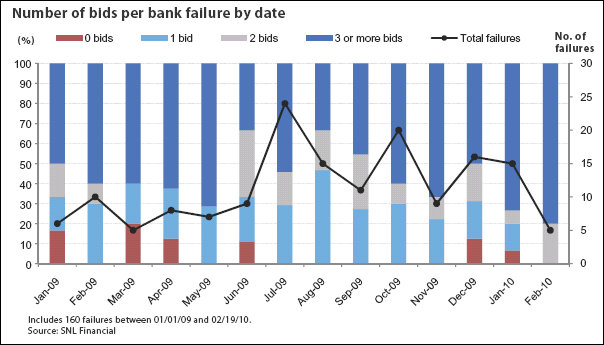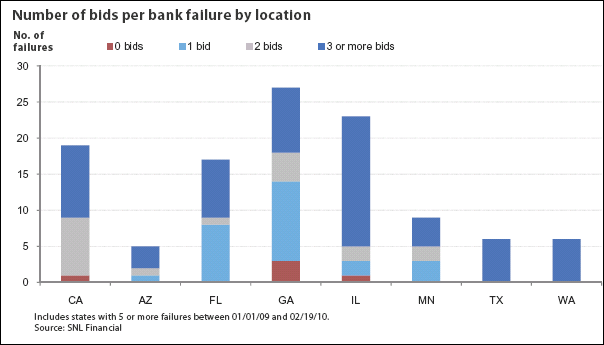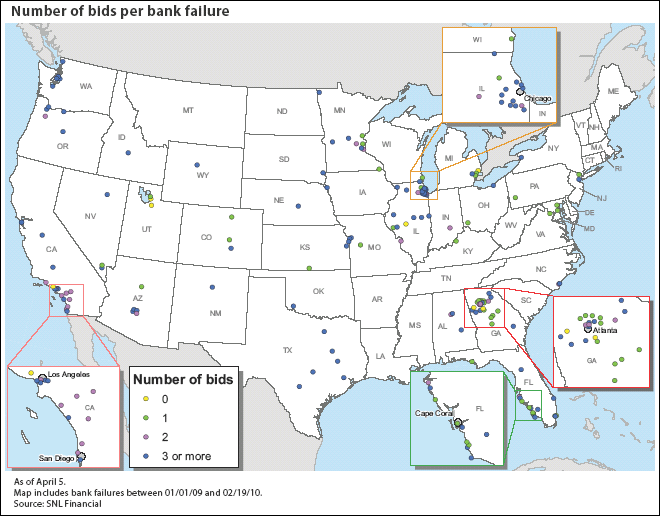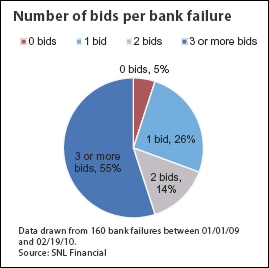The  bidding war for failed banks continued unabated into the initial months of 2010, according to the FDIC's new bid reports and data provided by the FDIC in response to a Freedom of Information Act request.
bidding war for failed banks continued unabated into the initial months of 2010, according to the FDIC's new bid reports and data provided by the FDIC in response to a Freedom of Information Act request.
Bank failures in recent months have drawn three or more bids more often than not. In January, 11 of the 15 bank failures brought in three or more bids, and the same may be said for four of the five failures that occurred between Feb. 1 and Feb. 19. In each month of 2009, with the exception of June, August and September, there have been more bank failures with at least three bids than with two or fewer bids.
Click  here to access a template containing bid data from all available bid documents filed in 2009 and 2010, as well as information from the FDIC's response to a Freedom of Information Act request regarding the number of bidders in bank failures between Jan. 1, 2009, and Feb. 19, 2010. The template also includes final agreement data for government-assisted transactions, such as the stated threshold of loss-share agreements, franchise premiums and the cost to the FDIC.
here to access a template containing bid data from all available bid documents filed in 2009 and 2010, as well as information from the FDIC's response to a Freedom of Information Act request regarding the number of bidders in bank failures between Jan. 1, 2009, and Feb. 19, 2010. The template also includes final agreement data for government-assisted transactions, such as the stated threshold of loss-share agreements, franchise premiums and the cost to the FDIC.

On a state level, not one institution has failed in Texas or Washington between Jan. 1, 2009, and Feb. 19, 2010, without drawing at least three bids from interested buyers.
The reason boils down to simple supply and demand. An abundance of banks based in Texas are potential bidders in any failure. Banks in the Lone Star state, for the most part, are healthy enough to make the term "Texas ratio" seem antiquated, as the median adjusted Texas ratio for all commercial banks, savings banks and savings institutions headquartered in the state came to about 6.5% as of Dec. 31, 2009. This compares to a median adjusted Texas ratio of 44.9% for institutions in Georgia, the state with the most failures this cycle. The median adjusted Texas ratio for all commercial banks, savings banks and savings institutions in the U.S. came to 15.8% at year-end 2009. SNL calculates an adjusted Texas ratio by dividing the sum of nonperforming assets and loans 90 or more days past due, both adjusted to exclude government-backed loans, by the sum of tangible equity and loan loss reserves.

And yet hometown heroes are not the only institutions bidding on Texas failures. Large franchises from as far away as Ohio, the banking sub of Minneapolis-based U.S. Bancorp, and Westbury, N.Y.-based New York Community Bancorp Inc., tossed their names in the ring for a chance at Texas' largest failure: Guaranty Bank, $13 billion as of June 30, 2009, a prize that went to Banco Bilbao Vizcaya Argentaria SA's Birmingham, Ala.-based subsidiary, Compass Bank.
In Washington, the waiting is the hardest part. Ray Davis, CEO of Portland, Ore.-based Umpqua Holdings Corp., a buyer in three Washington failures, said at a conference in March that failures in Washington have been slow due to a  reluctance on the part of the state superintendent to pull the trigger on floundering institutions. According to SNL data as of Dec. 31, 2009, there were 20 institutions in Washington with adjusted Texas ratios of more than 100%. As of March 22, approximately 24% of the operating institutions in Washington were under regulatory
reluctance on the part of the state superintendent to pull the trigger on floundering institutions. According to SNL data as of Dec. 31, 2009, there were 20 institutions in Washington with adjusted Texas ratios of more than 100%. As of March 22, approximately 24% of the operating institutions in Washington were under regulatory  cease and desist orders. Washington was home to three failures in 2009, but the frequency spiked in January 2010 when another three went under. Davis said he expects bidding to remain "very tight" in the near term in both Washington and Umpqua's home state of Oregon, which has been home to four failures since the start of 2009.
cease and desist orders. Washington was home to three failures in 2009, but the frequency spiked in January 2010 when another three went under. Davis said he expects bidding to remain "very tight" in the near term in both Washington and Umpqua's home state of Oregon, which has been home to four failures since the start of 2009.
Meanwhile, some of the major failure hot spots of the current cycle — Georgia, California and Florida — have seen fluctuating levels of demand for FDIC-assisted deals, but they have all seen occasional bouts of intense competition for the deposits and assets of their failing banks.
Illinois has seen the second-highest level of failures since the start of 2009, but buyer demand has remained strong. Eighteen of the state's 23 failures between Jan. 1, 2009, and Feb. 19, 2010, received three or more bids. The median deposit premium in Illinois was 1.00% for failures since the start of 2009, compared to 0.15% across the U.S. over that time period.

Georgia is the state that was home to the most bank failures since the start of 2009, but the failures have not been uniformly popular with the state's shrinking pool of bidders. The six banks owned by Woodstock, Ga.-based Security Bank Corp., for instance, each received just one bid. Five other Georgia failures have only received one bid apiece, and four have drawn two bids apiece. The Dec. 18, 2009, failure of Atlanta-based RockBridge Commercial Bank, drew two bids, but the FDIC opted to pay out the deposits instead of facilitating a deal. "Neither bid was less costly than liquidation," the FDIC's Division of Resolutions and Receiverships wrote in materials provided to SNL Financial in response to a Freedom of Information Act request for a list of failures by number of bids. Three failures in Georgia received no bids.
On a national level, more than half the bank failures between Jan. 1, 2009, and Feb. 19, 2010, have received three or more offers, according to details of the bidding contests culled from FDIC releases and the aforementioned FOIA request, which provided a list of all failures that only received one or two bids between Jan. 1, 2009, and Feb. 19, 2010. Of the 160 failures that occurred between those dates, eight did not receive a single bid.

The bidding details that have emerged since the FDIC stopped releasing copies of the actual bid forms and began releasing a new type of document, called a bid summary, provide insight into the number and type of bids received for a given bank failure, but the documents withhold certain details that followers of government-assisted deals have come to expect. The new reports do not include the second-highest bid, known as the cover bid, for instance. Nor, in most cases, do the reports contain the name of the company or group that submitted the cover bid. Other nonwinning bids and the bidders that submitted them are disclosed, but not with any association between bidder and bid.
The new style of bid disclosure can be traced back to an FDIC announcement from November 2009, which stated that the regulator would begin withholding the cover bid "to avoid impairment of the FDIC's statutory program for whole-bank resolutions and assets sales." The FDIC plans to make the cover bid public a year after the date of failure. Since the debut of the new type of report in February 2010, the FDIC has made 34 bid summaries public on its Web site. The reports have been released in clusters and not in chronological order.
The most recent batch covers three failures: the Dec. 18, 2009, failure of Santa Monica, Calif.-based First Federal Bank of California FSB; Miami-based Premier American Bank's Jan. 22 demise; and one of the most recent failures to date, that of Carrollton, Ga.-based McIntosh Commercial Bank on March 26. The bid summaries for 117 failures between June 2009 and March 2010 have yet to emerge.
Prior to releasing bid summary docs, the FDIC had made available to the public 105 bid forms submitted by failed bank bidders. The last known bid form released by the FDIC detailed Moultrie, Ga.-based Ameris Bank's winning bid in the Oct. 23, 2009, failure of Lawrenceville, Ga.-based American United Bank.
But months before American United went under, the FDIC had curtailed the practice of releasing bid forms submitted by runner-up bids following the controversial demise of Coral Gables, Fla.-based BankUnited FSB in May 2009. An investment vehicle headed up by former Goldman Sachs Group Inc. banker J. Christopher Flowers put an offer on the table for BankUnited that was arguably higher than the offer submitted by the winning bidder, a consortium led by former North Fork Bancorp CEO John Kanas.
According to international law firm Gibson Dunn & Crutcher LLP, the FDIC's rejection of the J.C. Flowers bid had less to do with the terms of the offer than concerns over how to "evaluate future losses under the proposed loss-share agreement." The law firm said in a July 1, 2009, press release that a note left by FDIC staff on the J.C. Flowers bid form suggested that the FDIC worried that J.C. Flowers would, without approval from the FDIC, transfer BankUnited assets that would have been subject to a loss-share agreement. Gibson Dunn & Crutcher said the estimated recovery value on assets "is likely tied to the knowledge and experience of the party that controls and manages those assets."
Gibson Dunn & Crutcher's take on the matter underscores the tenuous nature of the relationship between the FDIC and private equity. The FDIC in July 2009  proposed guidelines for private equity investments in failed banks that upped the requirements for participation in the auctions with the hope of weeding out potential bidders that might aim to strip down and sell off failed banks piece by piece instead of nurturing them back to health. The private equity industry
proposed guidelines for private equity investments in failed banks that upped the requirements for participation in the auctions with the hope of weeding out potential bidders that might aim to strip down and sell off failed banks piece by piece instead of nurturing them back to health. The private equity industry  was not too happy with the rules, which mandated capital levels and forbade silo structures. Some observers said the cost of resolving failures would
was not too happy with the rules, which mandated capital levels and forbade silo structures. Some observers said the cost of resolving failures would  increase due to the guidelines, as
increase due to the guidelines, as  fewer potential buyers would be allowed at the negotiating table.
fewer potential buyers would be allowed at the negotiating table.
Indeed, private equity's role in acquiring failed institutions has been nominal, with only 11 government-assisted deals involving  private equity buyers inked between Jan. 1, 2009, and Feb. 19, 2010. The OCC opened an avenue to private equity groups in November 2008 with its approval of a shelf charter filed by a group that aimed to buy failed banks. Since then, a number of groups have
private equity buyers inked between Jan. 1, 2009, and Feb. 19, 2010. The OCC opened an avenue to private equity groups in November 2008 with its approval of a shelf charter filed by a group that aimed to buy failed banks. Since then, a number of groups have  followed suit. As of Feb. 16, a total of 11 banks in organization intend to put capital to work via government-assisted deals.
followed suit. As of Feb. 16, a total of 11 banks in organization intend to put capital to work via government-assisted deals.
The FDIC's exclusion of cover bids from bid summaries, however, makes it difficult to say for certain how many banks operated by private equity groups are actively participating in failed bank auctions. What the data do support is the notion that potential buyers, be they private equity or strategic buyers such as local banks and regional players, remain hungry for failed banks.

